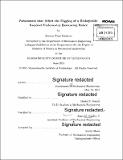Parameters that affect the digging of a biologically-inspired underwater borrowing robot
Author(s)
Guitron, Steven Paul
DownloadFull printable version (2.360Mb)
Other Contributors
Massachusetts Institute of Technology. Department of Mechanical Engineering.
Advisor
Daniel S. Dorsch and Amos G. Winter, V.
Terms of use
Metadata
Show full item recordAbstract
RoboClam 2 is a device that burrows based on the movement of the Atlantic razor clam. A functional RoboClam 2 has been built. Testing was conducted in a controlled laboratory environment to determine what parameters of the device and its operation affect its ability to dig both speedily, deeply, and efficiently. Smaller contraction and dilation volume, heavier device weight, and longer contractions above a theoretically calculated minimum fluidizing velocity were all found to correlate with faster digging speed. Future work will involve experimentally determining the minimum fluidizing velocity and the effect of contraction speed on digging ability.
Description
Thesis: S.B., Massachusetts Institute of Technology, Department of Mechanical Engineering, 2015. Cataloged from PDF version of thesis. Includes bibliographical references (page 29).
Date issued
2015Department
Massachusetts Institute of Technology. Department of Mechanical EngineeringPublisher
Massachusetts Institute of Technology
Keywords
Mechanical Engineering.